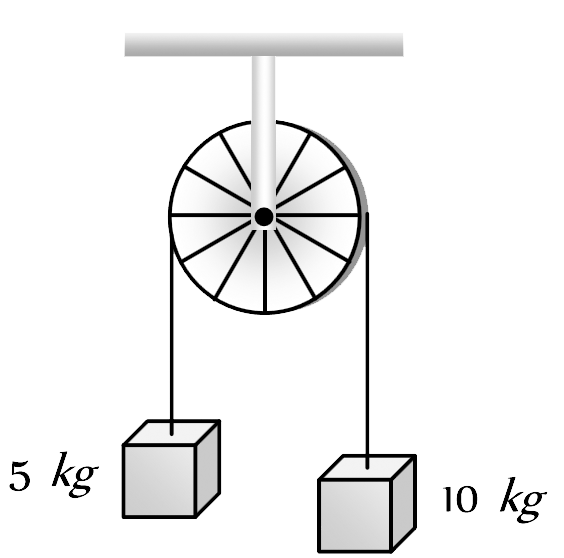The monkey B shown in fig. is holding on to the tall of the monkey A which is climbing up a rope. The masses of the monkeys A and B are 5 kg and 2kg respectively. If A can tolerate a tension of 30N in its tall, what force should it apply on the rope in order to carry the monkey B with it ?
(Take g=10ms−2)

Tmin=(5+2)g=7g=70N
Suppose maximum permissible acceleration of system is amax then equation of motion of or lower monkey
T1−2g=2amax⇒T1=2g+2amax
given T1=30N
2g+2amax=30
amax=5m/s2
∴ for system T=(502)(10+5)=105N

Topper's Solved these Questions
- NEWTONS LAWS OF MOTIONBook:ALLENChapter:NEWTONS LAWS OF MOTIONExercise:EXERCISE-I
Explore 52 Videos
- NEWTONS LAWS OF MOTIONBook:ALLENChapter:NEWTONS LAWS OF MOTIONExercise:EXERCISE-II
Explore 112 Videos
- NEWTONS LAWS OF MOTIONBook:ALLENChapter:NEWTONS LAWS OF MOTIONExercise:EXERCISE-III
Explore 28 Videos
- NEWTON'S LAWS OF MOTION & FRICTIONBook:ALLENChapter:NEWTON'S LAWS OF MOTION & FRICTIONExercise:EXERCISE (JA)
Explore 4 Videos
- RACEBook:ALLENChapter:RACEExercise:Basic Maths (Wave Motion & Dopplers Effect) (Stationary waves & doppler effect, beats)
Explore 25 Videos
Similar Questions
USS 150) Two masses of 5 kg and 10 kg are connected to a pulley as shown. What will be the acceleration of the system (g= acceleration due to gravity)

View SolutionA particle is in straight line motion with uniform velocity A force is not required
View SolutionAssertion: The driver in a vechicle moving with a constant speed on a straight road is in a non-inertial frame of referance.
Reason: A reference frame in which Newton's laws of motion are applicable is non-inertial.
View SolutionA piece of wire is bent in the shape of a parabola y=kx2 (y-axis vertical) with a bead of mass m on it. The bead can slide on the wire without friction. It stays at the lowest point of the parabola when the wire is at rest. The wire is now accelerated parallel to the x-axis with a constant acceleration a. The distance of the new equilibrium position of the bead, where the bead can stay at rest with respect to the wire, from the y-axis is:
View SolutionThe frequency of a radar is 780 MHz. After getting reflected from an approaching aeroplane, the apparent frequency is more than the actual frequency by 2.6 kHz. The aeroplane has a speed of
View SolutionThe monkey B shown in the figure is holding on the tail of the monkey. A which is climbing up a rope. The masses of the monkeys A and B are 40kg and 20kg , respectively. If A can tolerate a tension of 300N in its fail, what force should it apply on the rope in order to carry the monkey B with it?
View SolutionA monkey of mass 30 kg climbs a rope which can withstand a maximum tension of 360 N. The maximum acceleration which this rope can tolerate for the climbing of monkey is:
(g=10m/s2)
View SolutionA monkey of 25 kg is holding a vertical rope. The rope does not break if a body of mass 30 kg is suspended with the rope exceeds 30 kg. What will be the maximum acceleration with which the monkey can climb up along the rope ? ( Take , =10 ms^(-2) )
View Solutionचित्र में छत से एक रस्सी बँधी है | उस रस्सी के सहारे बंदर A ऊपर चढ़ रहा है | बंदर B ने उसकी पूँछ पकड़ रखी है | बंदरों A तथा B के द्रव्यमान क्रमश : 5 kg एवं 2 kg हैं | यदि बंदर A अपनी पूँछ में अधिकतम 30 N का तनाव सह सकता है तो यह B को अपने साथ रखते हुए रस्सी पर अधिकतम कितना बल लगा सकता है ?

View SolutionA monkey of mass 40 kg climbs a rope. Which can stand a maximum tension of 600 N. In which of the following cases will the rope break? The monkey
View SolutionA monkey of mass 40 kg climbs a rope. Which can stand a maximum tension of 600 N. In which of the following cases will the rope break: The monkey
climbs up with a uniform speed of 5 m⋅s−1
View SolutionA monkey of mass 40 kg climbs on a rope which can withstand a maximum tension of 600 N.In which of the following cases will the rope break? The monkey- climbs up with an acceleration of 6 m cdot s^(-2)
View SolutionA monkey of mass 40 kg climbs on a massless rope of breaking strength 600 N. The rope will break if the monkey. (Take g=10m/s2)
View SolutionA monkey of mass 20 kg is holding a vertical rope which breaks under a force of 25 kgf. What is the maximum acceleration with which the monkey can climb up the rope ?
View SolutionA monkey A (mass = 5kg) is climbing up a rope tied to a rigid support. The monkey B (mass = 2kg) is holding on to the tail of monkey A. If the tail can tolerate a maximum tension of 30N, what force should monkey A apply on the rope in order to carry monkey B with it? (g=10m/s2).
View SolutionThe monkey B shown in the picture is holding the tail of monkey A, who is climbing the rope. The masses of monkeys A and B are 2 kg and 5 kg respectively. If A can bear 30 Newton's tension on his tail, how much force must be applied to the rope to lift it with monkey B? (g = 10 "मी/से"^2 )
View Solution

